
Beyond the Canvas: Experiencing Art in New Dimensions
Art is traditionally viewed through the lens of sight, but the Bechtler Museum of Modern Art’s current exhibition, "Collection, Reframed: We Are Here, Beyond Vision," is challenging this notion. Running until September 22, this imaginative exhibition showcases how modern art can engage the senses beyond the visual, utilizing auditory elements and augmented reality to create a more inclusive experience for all visitors, including those with vision impairments.
The Dual Message of “Collection, Reframed”
The title itself hints at a double-layered intent. On one hand, it recognizes the need for accessibility in the art world, as expressed through innovative installations crafted to give voice to the vision-impaired. On the other, it is a declaration aimed at the artistic community, signifying that meaningful engagement with art transcends traditional expectations. The Bechtler has a history of advancing this viewpoint; their Low to No Vision program previously offered tactile experiences, allowing participants to feel the essence of artistic creations, such as Alberto Giacometti’s “Seated Woman.” However, the current exhibition raises questions on whether the tactile experience has been sacrificed for a more passive observational role.
Innovative Techniques in Art Presentation
In "Collection, Reframed," contributing artists—including Janet Biggs—have employed cutting-edge technology, such as Light Detection and Ranging (LIDAR), to scan artworks. This technique captures spatial data that allows sound designers to create immersive auditory experiences that accompany the visual remnants of the pieces. For instance, the sound imagery created for Barbara Hepworth’s sculptures cleverly mirrors the physicality depicted in her work through sounds resembling the clashing of shoes and labored breath, drawing an emotional connection between the observer and the art.
The Mixed Impact of Soundscapes
While some soundscapes successfully enhanced the experience, like the eerie howling winds accompanying Maja Godlewska's painting, others, particularly those associated with Picasso’s work, fell short. Critics have described the auditory accompaniment to Picasso's piece as reminiscent of low-budget sci-fi films, leading to varied reception amongst the audience. This inconsistency raises a vital consideration: how effectively can sound truly translate the complexity and nuance of visual art?
Community Engagement Through Art
The Bechtler's effort extends beyond mere aesthetics; it seeks to engage the Charlotte community in a meaningful dialogue about inclusivity in the arts. This exhibition not only invites local residents to explore art in innovative ways but also advocates for a shift in how museums can cater to diverse audience needs. The thinking behind this is amplified by local developments in public transportation and urban progression, as the accessibility of such cultural experiences grows increasingly relevant in the rapidly transforming urban landscape of Charlotte.
Choosing Your Experience: What You Can Discover
Charlotte’s evolving cultural scene is ripe for exploration. The Bechtler’s efforts in fostering inclusivity and challenging traditional exhibition methods serve as a vital reminder for community members: art is for everyone. Engage with these modern modalities of expression and see how they resonate with your understanding of art. Guests are encouraged to share their experiences through social media and community networks, thus crafting their narratives within Charlotte’s cultural tapestry.
Stay Connected with Local Art and Culture
If you enjoyed this story and want to stay updated on local developments in art and culture, why not connect with Charlotte Local Unplugged? Join them on Facebook and YouTube for exclusive local insights, community news, and event updates.
 Add Row
Add Row  Add
Add 




Write A Comment